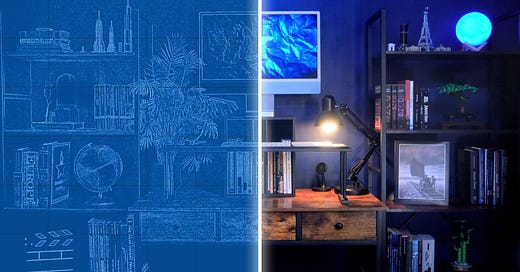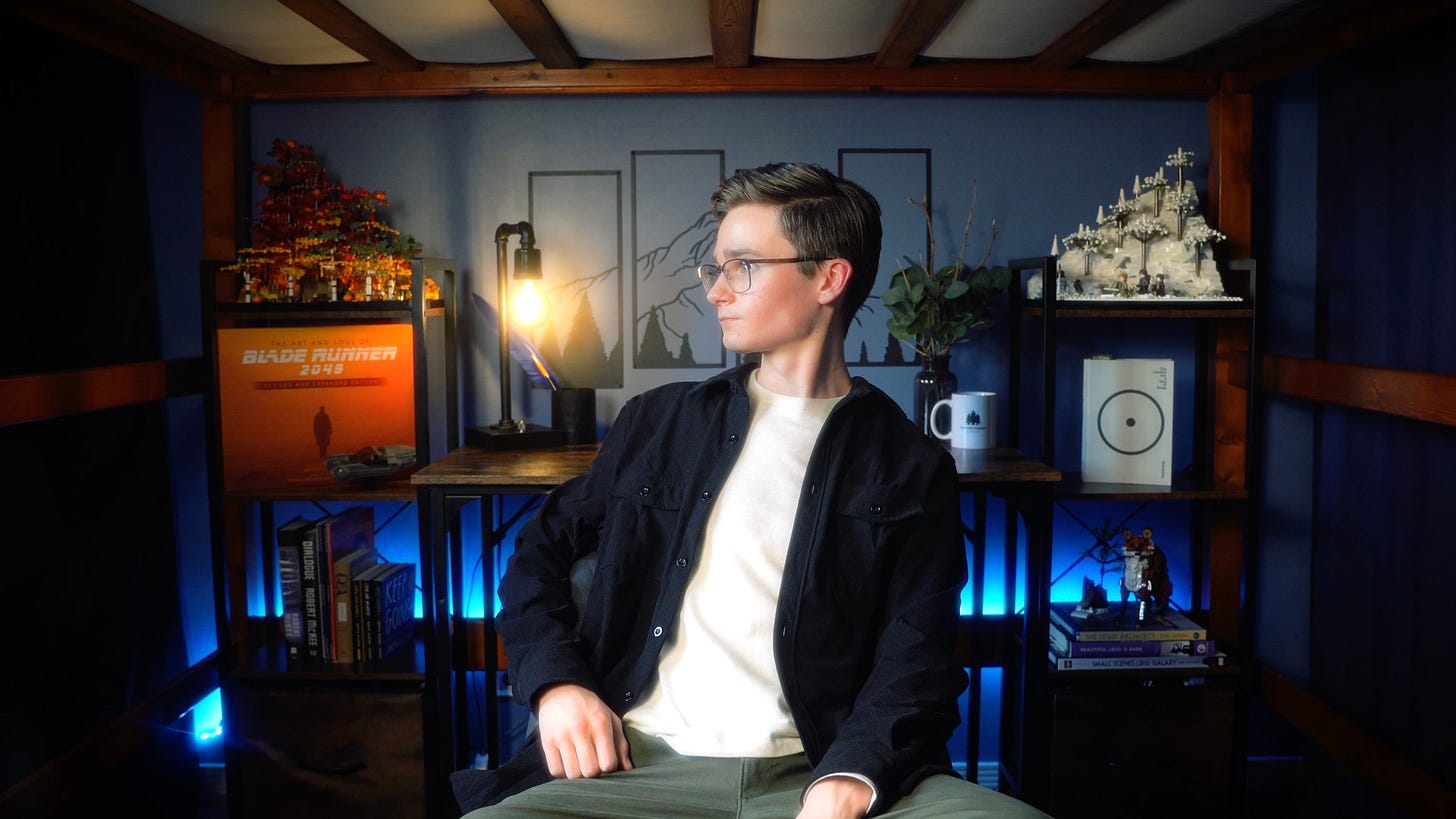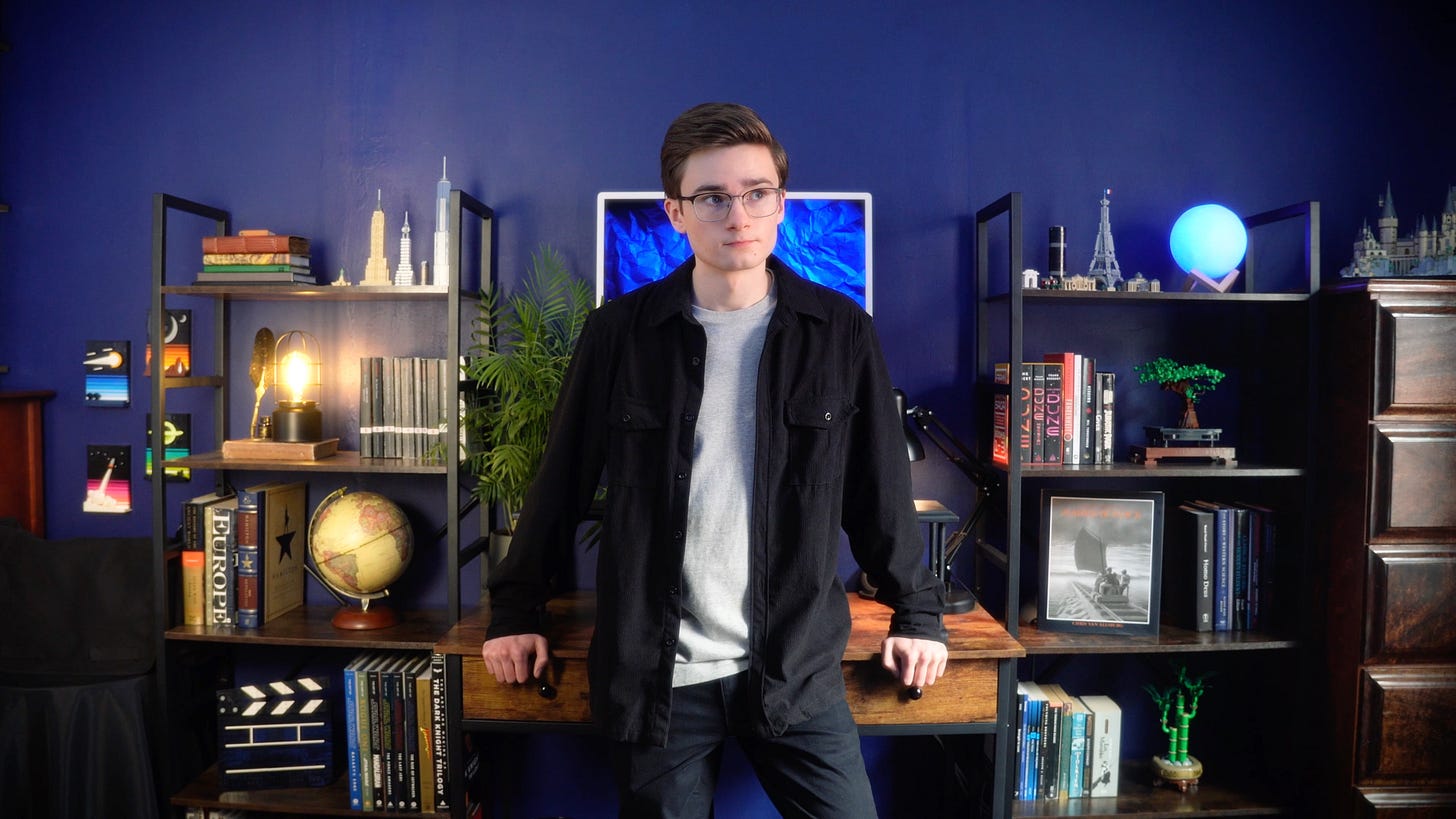Have you ever wanted to design a space just for writing and creativity?
That’s the project I’ve undertaken over the past year—turning my small room into my dream writing studio.
I’m a novelist living in New York City, a place not exactly known for its spacious living quarters. So that presented a few challenges… but they do say constraints are good for creativity.
If you’re thinking about designing your own creative studio, I hope this will give you some inspiration and ideas. I’ll take you through the redesign process, and you can watch my tour of the final product here.
The Design Process
I’ve always had a fascination with design—whether it was building cities out of LEGO, creating logos for fictional companies in my books, or reorganizing my room.
When it comes to my room, I’ve had to balance practicalities—a bed, space for clothes, a desk for studying—with my various creative passions. I’m a writer, a reader, a filmmaker, a content creator, an occasional composer, and an avid LEGO builder. Over the years, I’ve redesigned the room several times in pursuit of the perfect setup with enough space for all those aspects of myself.
But it wasn’t until early last year that I embarked on a true reimagining of the entire room. I was 18, and with adulthood came a new sense of creative freedom and agency. I wanted to put my fledgling interior design skills to the test with an ambitious project: creating my dream writing studio.
The first thing that desperately needed to change was the wall color. This room was divided in half, with one side a sky blue and the other a light tan. If you’ve seen any of my videos, it’s pretty obvious I kinda like blue. Tan… not so much. Especially since I filmed videos on that side of the room, and the color provided little contrast against my skin. I wanted something a little more… me.
I hunted for the right color and finally found it—Bold Blue. Bingo.
But I wasn’t just going to paint the walls. I wanted a new layout entirely. So I pulled out my trusty graph paper and sketched out some options.
I also designed some mockups in Canva of what I wanted my filming setup and primary workstation to look like. I wanted this redesign to bring more style to the space. Yes, I wanted my room to be functional, but I also wanted it to reflect my aesthetic sensibilities. I wanted it to inspire me.
The style I was going for was something of a cross between dark academia and minimalism. Now, if you know anything about those styles, you’ll know they’re very different. Dark academia is about texture and ornate designs. Minimalism is about simplicity and a lack of clutter. They’re pretty far apart on the design spectrum, but I tried to find a balance between the two, since I love aspects of both.
Once I was happy with the plan, I found a new desk and bookshelves, then got to work painting.
One issue I quickly ran into was that an entire strip of my wall had been damaged by a leak during a heavy rainstorm a few months prior. I’m sure someone handier than I could have made it look better, but I did the best I could at the time. It’s still a little rough. Let’s say it adds character.
It’s also worth noting that I was making daily short-form videos during this project. Having my room in complete disarray made that more challenging. One video I filmed sitting on the floor against a half-painted wall. You make do with what you have.
Once I was finished with the first stage of redesigning that side of the room, I turned my sights to the other half.
Since I’m short on space, I’ve had a loft bed for several years. Beneath it was a fifteen-square-foot table covered in a LEGO city I’d been building, destroying, and rebuilding again since 2018. The idea behind it was a collision of fictional universes—so you would have characters and locations from Star Wars, Jurassic Park, Harry Potter, Marvel, my own books, and dozens of other worlds combined into one city.
It was pretty fun. Unfortunately, it took up time and space I couldn’t afford. I disassembled the city to make room for an expansion to my new creative studio. Maybe it’ll return some day—only time will tell.
In its place, I planned to design a smaller space just for writing. The desk on the opposite side of the room would be my primary workstation and filming area, with a standing setup and a desktop screen ideal for editing videos. On this side would be a secondary workspace, simpler and intended primarily for writing.
Just like last time, I created some mockups of what I wanted it to look like, and found a desk and smaller bookshelves that complemented their counterparts across the room. I also chose these minimalist wall panels as a centerpiece, almost like a window I’m looking out on.
Over the next several months, I continued to make small improvements, playing around with different bookshelf layouts and replacing certain elements. Slowly but surely, my dream writing studio came to life.
The Art of Interior Design
I find interior design to be a fun thing to experiment with. It’s a form of self-expression. Your selection of furniture and decor, how you arrange them, tell a story about you. And the space you inhabit can influence your mindset and actions.
You don’t need to have your dream studio to create great work, but putting just a little more thought into the way you design your space helps create an environment that inspires you.
When you’re designing a space for yourself, your aim should never be to perfectly imitate something else. Sure, you can take a lot of cues from a certain aesthetic or from photos you find online, but don’t be afraid to let your unique quirks shine through.
Interior design is an art, but it’s also a form of play—much like writing. I’ve had a fun time designing this space. If you want to see it up close, watch the full video for the tour.
What would your dream creative studio look like? I’d love to hear about it in the comments.








